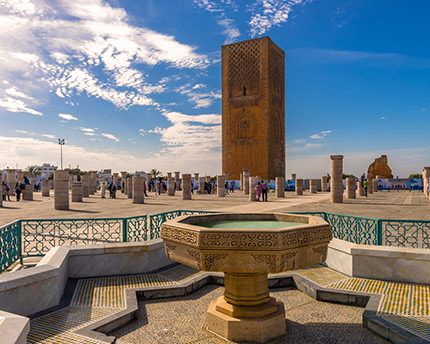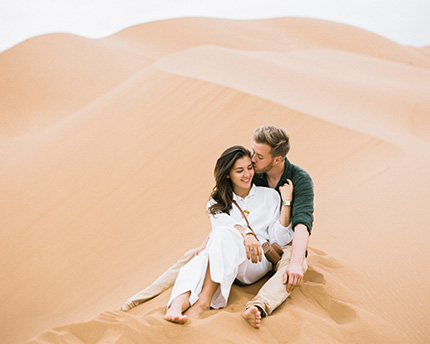Unknown and overlooked by many, Rabat is an interesting city to visit on a trip to Morocco. Its streets are steeped in a rich history that is well worth discovering to understand Morocco and its past a little better. If you’ve ever wondered if there is tourism in Rabat, read on…you might get a nice surprise.
Already the capital in the time of the Alawi Dynasty, which has reigned over the kingdom since the 17th century, Rabat was made the official capital of Morocco after it become independent from France and Spain in 1956.
Rabat remains off the popular tourist trail, and is often overshadowed by Marrakesh, Fez and Essaouira. This post reveals the main places to visit in Rabat that are essential stops on your trip.
- Mausoleum of Mohammed V
- Hassan Tower
- Chellah Necropolis
- Rabat Medina
- Kasbah of the Udayas
- Andalusian Gardens
- Rabat Mellah
- Dar al-Makhzen (Royal Palace)
- Where to eat in Rabat
- What to see near Rabat
- Advice when travelling
- How to get to Rabat
Mausoleum of Mohammed V
Mohammed V is thought of as the father of modern Morocco and was a key figure in the country’s process of independence. He was sultan of Morocco from 1927 to 1957 and later king, after independence, from 1957 to 1961. Tribute is paid to him here, at the Mausoleum of Mohammed V, where his remains were laid to rest.
This royal tomb was built between 1961 and 1971 in a traditional, Arab-Andalusí style with a marble façade and roofs made from wood from the Atlas Mountains. Mohammed V is buried here with the remains of his sons, Prince Moulay Abdallah and King Hassan II, monarch from 1961 to 1999.
The building has a dazzling beauty that adds to its great symbolic importance to the country. Inside, an impressive hall contains the sarcophagus of Mohammed V, which lies in the centre surrounded by Moroccan flags and watched over by the Royal Guard.
Hassan Tower
Hassan Tower stands next to the mausoleum and is a symbol of Rabat. This unfinished tower is the only lasting trace of what was intended to be the largest mosque in the world, beating those in Seville and Marrakesh for size.
Begun under the rule of Sultan Al Mansur, the ruler’s death in 1199 meant that the project was permanently abandoned. A forest of columns at the foot of the tower reminds visitors of the great temple that never was.
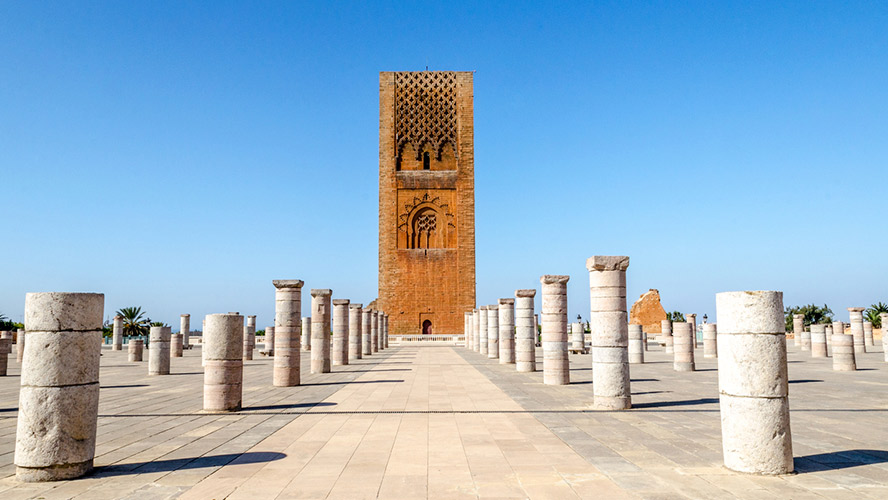
Chellah Necropolis
Located outside the city, Chellah Necropolis represents Rabat’s Roman and medieval past. This site offers visitors the chance to admire buildings from the Roman and Marinid Empires, including walls, gates, a minaret, a triumphal arch and the remains of the forum, thermal baths and madrasa. The necropolis is an outstanding archaeological site that is key to better understanding Rabat’s past.
Rabat Medina
Like all Moroccan cities, the medina quarter is a treasure that mustn’t be missed; Rabat Medina was made a UNESCO World Heritage Site in 2012. The market spreads out throughout the whole walled city and aimlessly wandering the streets is the best way to explore it. Forget working out a route in advance and let yourself be guided by the colours, scents, noises and products that enliven this vast medina.
Bab El Alou and Bab El Had gates are the entrances to the walled area that encloses this historic centre, the heart and soul of Rabat.
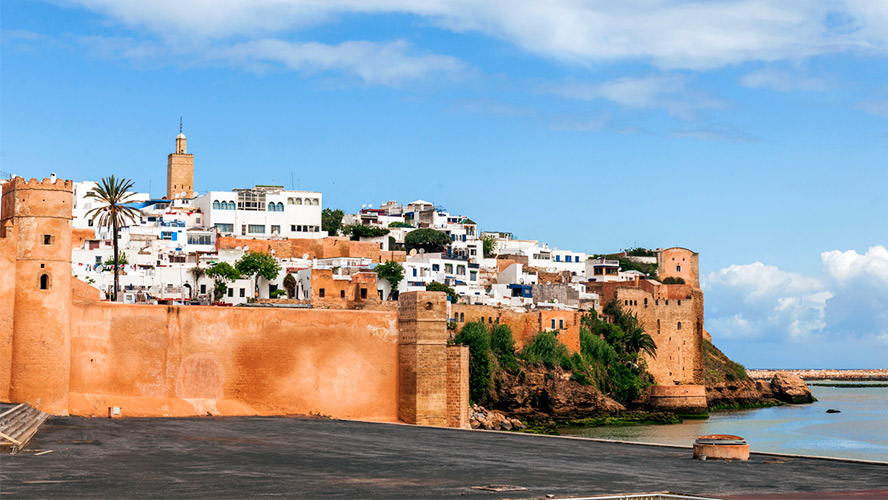
Kasbah of the Udayas
Kasbahs are ancient citadels or fortresses that have endured until the present day in many cities across Morocco. Rabat Kasbah is in the corner of the city and is a watchtower on the shores of the Bu Regreb River estuary. Its origins can be traced back to the 12th century but it also features 18th century elements.
The kasbah owes its name to the Oudaya tribe who formerly populated this area. Just like other kasbahs, time seems to stop as you wander its narrow streets.
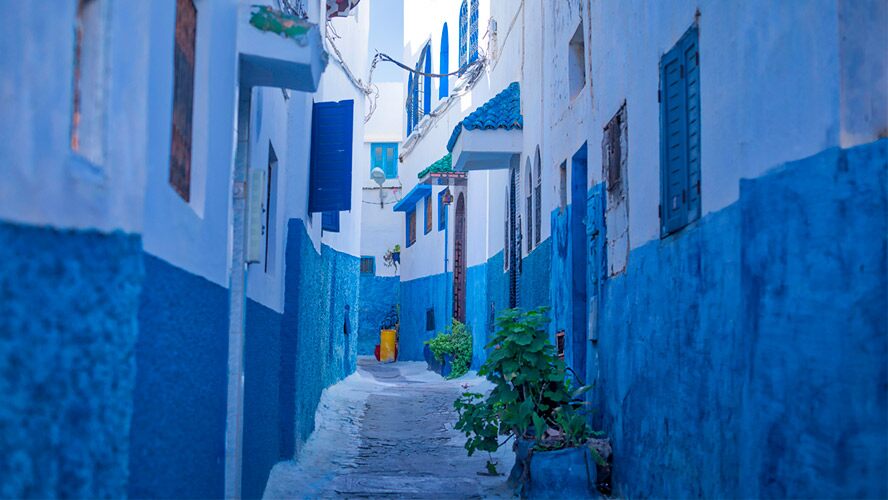
Andalusian Gardens
Rabat Kasbah is home to the Andalusian Gardens, one of the city’s most famous green spaces. This oasis has a wide variety of plants and was created at the beginning of the 20th century; visitors here feel as though they are magically transported to the Alhambra in Granada.
Rabat Mellah
Rabat Mellah is the city’s Jewish quarter. It stands atop the small cliffs along the shore of the Bu Regreg River and is another walled enclave with narrow streets where visitors happily lose their way.
Dar al-Makhzen (Royal Palace)
Dar al-Makhzen Palace is the official residence of the king of Morocco and is Rabat’s royal palace. It was built in 1864 on the ruins of an earlier palace. Highlights include its huge entrance gate that looks towards the large Mechouar esplanade.
Where to eat in Rabat
Being the capital of Morocco, Rabat has many wonderful restaurants where you can enjoy a great meal. Here are some suggestions:
- Dar Zaki: in the medina, this cosy and pleasant restaurant is the perfect place to sample the most famous Moroccan dishes.
- Dar Naji: next to Bab El Had gate and the walls, this popular restaurant serves traditional food and has a great atmosphere.
- La Menora: if you’re looking for something more special and don’t mind higher prices, La Menora is an excellent option. It has an elegant courtyard and menu that features Moroccan and Mediterranean dishes.
- Restaurant de la Libération: this restaurant is visited by locals, guaranteeing quality food and reasonable prices in the heart of the medina.
- Café Maure: located in the kasbah, this café is perfect for having a cup of tea and typical Moroccan pastries while enjoying wonderful views.
What to see near Rabat
Rabat is in the centre Morocco’s Atlantic coastline and is conveniently located for visiting nearby cities such as Casablanca or Meknes on an easy day trip. Casablanca, Meknes, Fez and Rabat are known as Morocco’s imperial cities and have each been the capital of the kingdom at different points in its history. Together they all make an interesting tourist route for exploring Morocco.
Advice when travelling
Rabat isn’t as tourist-orientated as other Moroccan cities but it’s perfectly safe during the day, and the people are kind and willing to help. You should take care at night, once the medina empties after 10 pm, just like in any other city.
The city is the perfect size for exploring on foot and visiting the main tourist sights without needing to use public transport.
People mainly speak Arabic and French, but also a little Spanish, which can be helpful when communicating with locals.
How to get to Rabat
As we mentioned above, Rabat is conveniently located and is easy to travel to. One big advantage is that one of Morocco’s few train lines passes through the city, making it very straightforward to travel between the imperial cities and places in the north of Morocco, such as Tangier. As the country’s capital, it has one of the main airports with connections to many European cities.
To get an idea of its distance from other Moroccan cities, Rabat is 90 km from Casablanca, 150 km from Meknes, 200 km from Fez and 320 km from Marrakesh.
























































